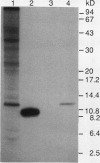Abstract
The phytopathogenic fungi Phytophthora subspecies elicit hypersensitive-like necroses on their nonhost tobacco (Nicotiana tabacum), with the exception of the tobacco pathogen Phytophthora nicotianæ. In culture, these fungi—except P. nicotianæ—secrete proteins, called elicitins, that cause these remote leaf necroses and are responsible for the incompatible reaction. These proteins protect tobacco against invasion by the agent of the tobacco black shank, P. nicotianæ, which is unable to produce such an elicitor. Cryptogein, secreted by Phytophthora cryptogea, has been purified, sequenced, and characterized as an elicitin, a novel family of 10 kilodalton holoproteins. In the present paper, we examined the secretion and biosynthesis of this protein elicitor from P. cryptogea culture. Results showed that the secretion of cryptogein began later than its synthesis and stopped earlier, simultaneously with mycelium growth, when the nitrogen source in the culture medium was nearly exhausted. Electrophoretic patterns of total protein from mycelium extracts and N-terminal sequence analysis showed that cryptogein accumulated in the mycelium in its mature form. The comparison of the immunoselected in vitro translation products with 35S in vivo-labeled cryptogein showed that cryptogein was synthesized as a preprotein with a signal peptide removed cotranslationally before the secretion into the culture medium. Immunoselected in vitro-synthesized products were subjected to radiosequencing to clearly determine the N-terminal position and the size (20 amino acids) of the signal peptide. Cryptogein did not undergo any other posttranslational modification.
Full text
PDF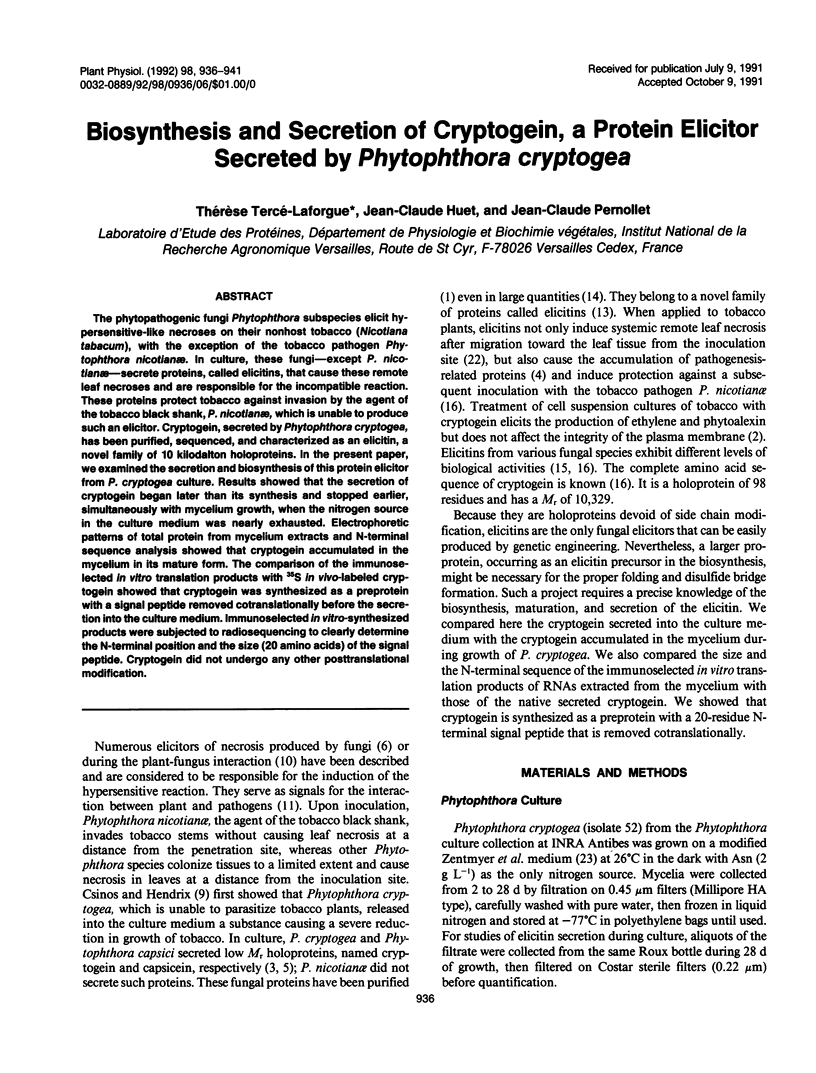
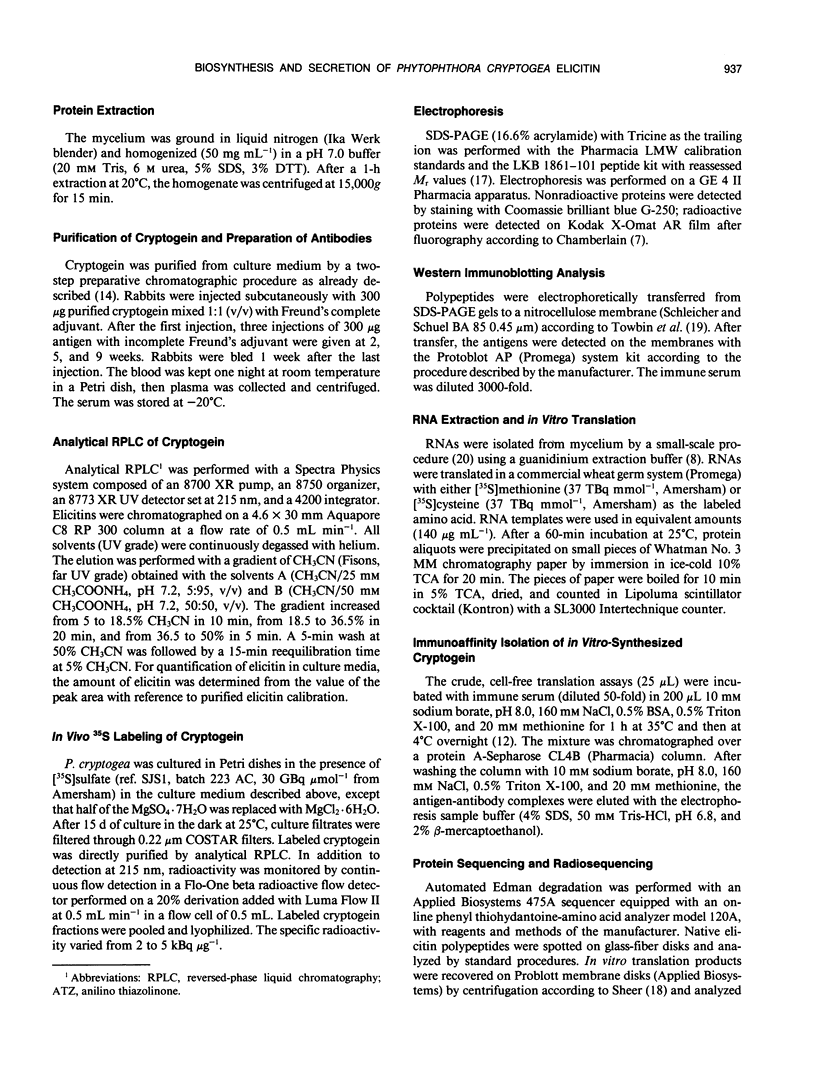
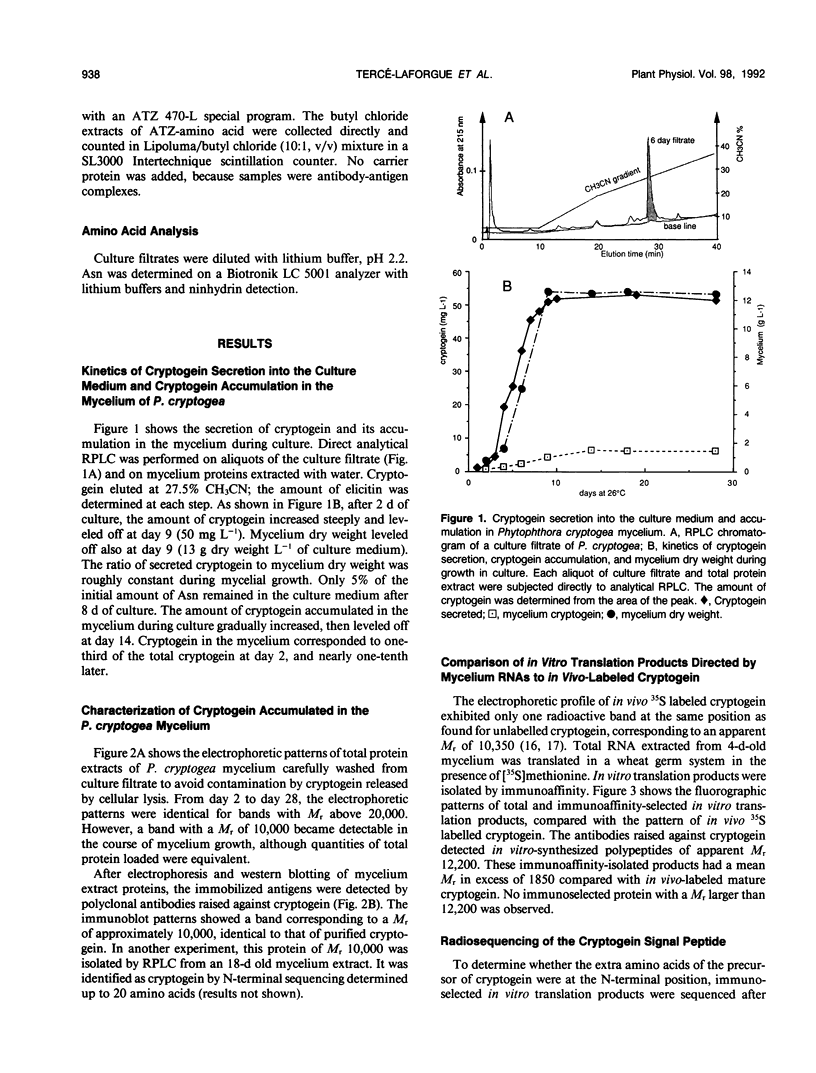
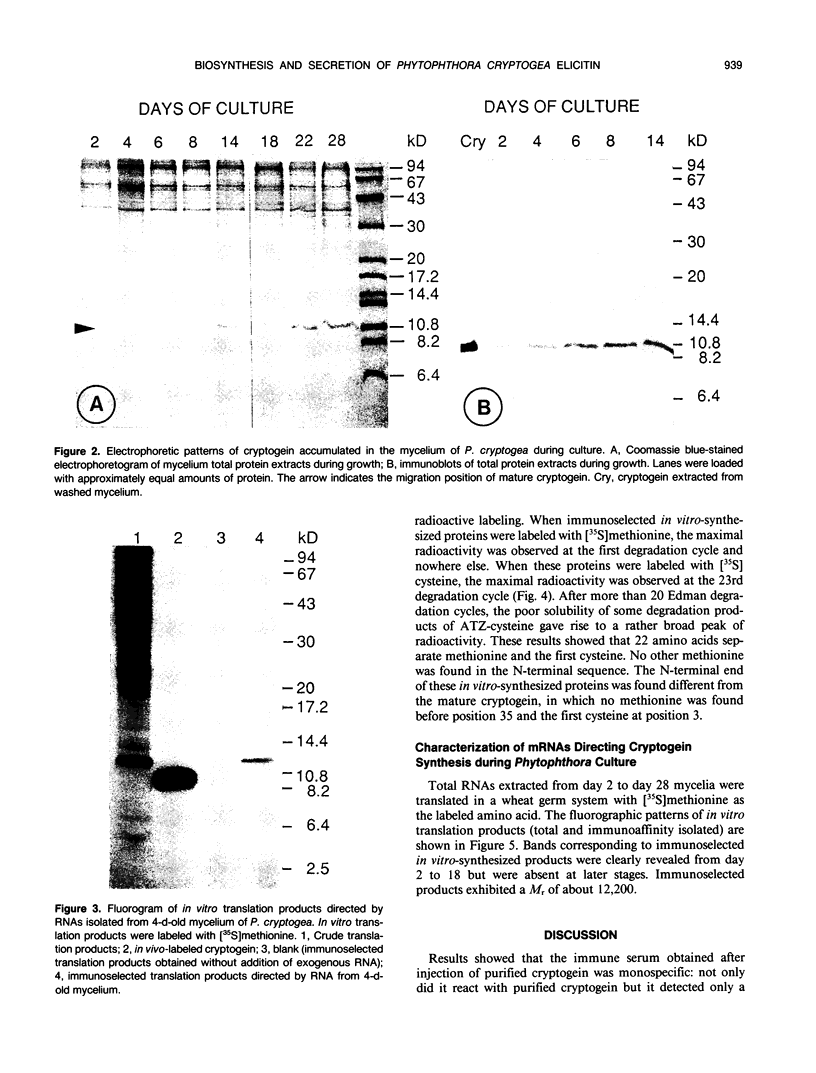
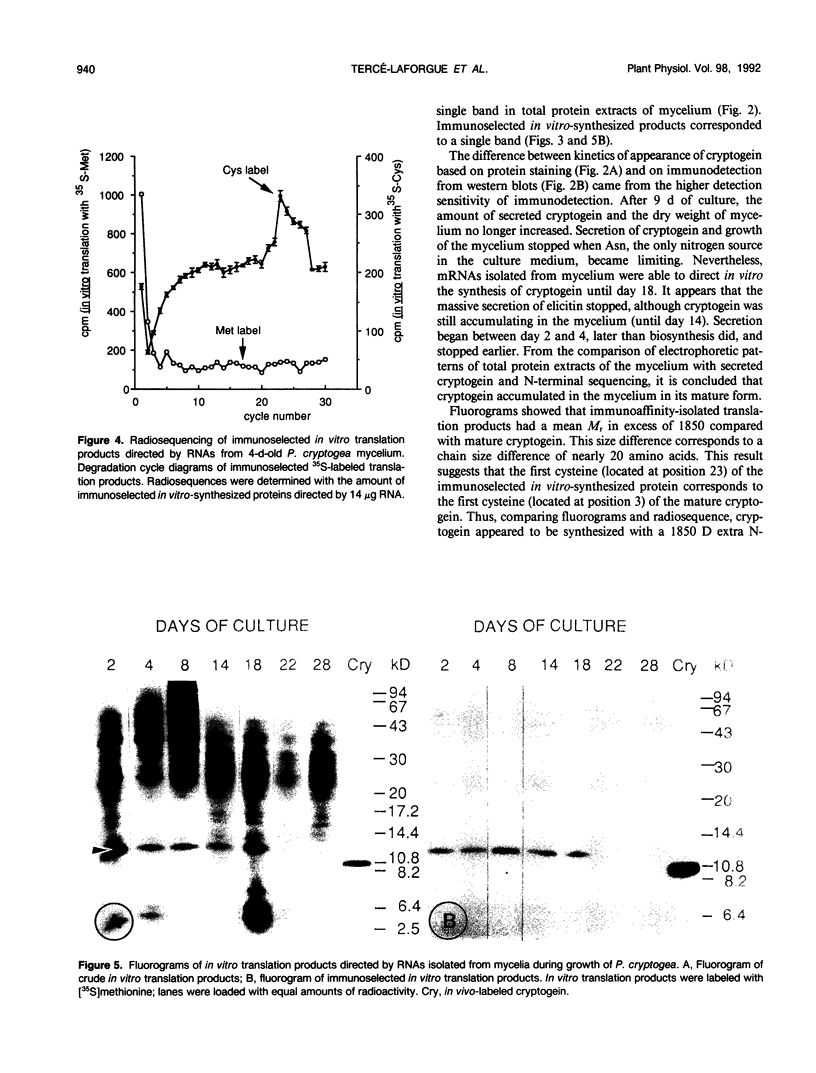
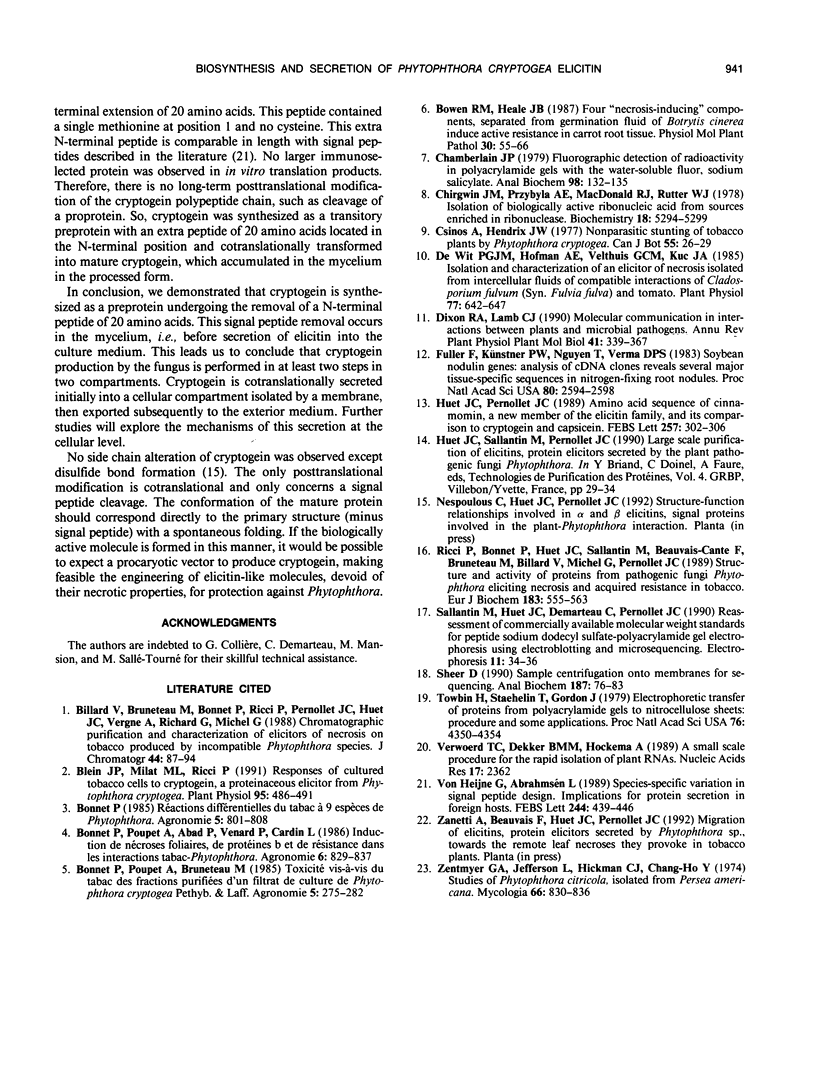
Images in this article
Selected References
These references are in PubMed. This may not be the complete list of references from this article.
- Blein J. P., Milat M. L., Ricci P. Responses of Cultured Tobacco Cells to Cryptogein, a Proteinaceous Elicitor from Phytophthora cryptogea: Possible Plasmalemma Involvement. Plant Physiol. 1991 Feb;95(2):486–491. doi: 10.1104/pp.95.2.486. [DOI] [PMC free article] [PubMed] [Google Scholar]
- Chamberlain J. P. Fluorographic detection of radioactivity in polyacrylamide gels with the water-soluble fluor, sodium salicylate. Anal Biochem. 1979 Sep 15;98(1):132–135. doi: 10.1016/0003-2697(79)90716-4. [DOI] [PubMed] [Google Scholar]
- Chirgwin J. M., Przybyla A. E., MacDonald R. J., Rutter W. J. Isolation of biologically active ribonucleic acid from sources enriched in ribonuclease. Biochemistry. 1979 Nov 27;18(24):5294–5299. doi: 10.1021/bi00591a005. [DOI] [PubMed] [Google Scholar]
- De Wit P. J., Hofman A. E., Velthuis G. C., Kuć J. A. Isolation and Characterization of an Elicitor of Necrosis Isolated from Intercellular Fluids of Compatible Interactions of Cladosporium fulvum (Syn. Fulvia fulva) and Tomato. Plant Physiol. 1985 Mar;77(3):642–647. doi: 10.1104/pp.77.3.642. [DOI] [PMC free article] [PubMed] [Google Scholar]
- Fuller F., Künstner P. W., Nguyen T., Verma D. P. Soybean nodulin genes: Analysis of cDNA clones reveals several major tissue-specific sequences in nitrogen-fixing root nodules. Proc Natl Acad Sci U S A. 1983 May;80(9):2594–2598. doi: 10.1073/pnas.80.9.2594. [DOI] [PMC free article] [PubMed] [Google Scholar]
- Huet J. C., Pernollet J. C. Amino acid sequence of cinnamomin, a new member of the elicitin family, and its comparison to cryptogein and capsicein. FEBS Lett. 1989 Nov 6;257(2):302–306. doi: 10.1016/0014-5793(89)81557-1. [DOI] [PubMed] [Google Scholar]
- Ricci P., Bonnet P., Huet J. C., Sallantin M., Beauvais-Cante F., Bruneteau M., Billard V., Michel G., Pernollet J. C. Structure and activity of proteins from pathogenic fungi Phytophthora eliciting necrosis and acquired resistance in tobacco. Eur J Biochem. 1989 Aug 15;183(3):555–563. doi: 10.1111/j.1432-1033.1989.tb21084.x. [DOI] [PubMed] [Google Scholar]
- Sallantin M., Huet J. C., Demarteau C., Pernollet J. C. Reassessment of commercially available molecular weight standards for peptide sodium dodecyl sulfate-polyacrylamide gel electrophoresis using electroblotting and microsequencing. Electrophoresis. 1990 Jan;11(1):34–36. doi: 10.1002/elps.1150110108. [DOI] [PubMed] [Google Scholar]
- Sheer D. Sample centrifugation onto membranes for sequencing. Anal Biochem. 1990 May 15;187(1):76–83. doi: 10.1016/0003-2697(90)90419-a. [DOI] [PubMed] [Google Scholar]
- Towbin H., Staehelin T., Gordon J. Electrophoretic transfer of proteins from polyacrylamide gels to nitrocellulose sheets: procedure and some applications. Proc Natl Acad Sci U S A. 1979 Sep;76(9):4350–4354. doi: 10.1073/pnas.76.9.4350. [DOI] [PMC free article] [PubMed] [Google Scholar]
- Verwoerd T. C., Dekker B. M., Hoekema A. A small-scale procedure for the rapid isolation of plant RNAs. Nucleic Acids Res. 1989 Mar 25;17(6):2362–2362. doi: 10.1093/nar/17.6.2362. [DOI] [PMC free article] [PubMed] [Google Scholar]
- Zentmyer G. A., Jefferson L. Studies of Phytophthora citricola, isolated from Persea americana. Mycologia. 1974 Sep-Oct;66(5):830–845. [PubMed] [Google Scholar]
- von Heijne G., Abrahmsén L. Species-specific variation in signal peptide design. Implications for protein secretion in foreign hosts. FEBS Lett. 1989 Feb 27;244(2):439–446. doi: 10.1016/0014-5793(89)80579-4. [DOI] [PubMed] [Google Scholar]




